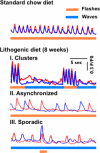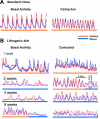Disruption of gallbladder smooth muscle function is an early feature in the development of cholesterol gallstone disease
- PMID: 22621672
- PMCID: PMC3378777
- DOI: 10.1111/j.1365-2982.2012.01935.x
Disruption of gallbladder smooth muscle function is an early feature in the development of cholesterol gallstone disease
Abstract
BACKGROUND; Decreased gallbladder smooth muscle (GBSM) contractility is a hallmark of cholesterol gallstone disease, but the interrelationship between lithogenicity, biliary stasis, and inflammation are poorly understood. We studied a mouse model of gallstone disease to evaluate the development of GBSM dysfunction relative to changes in bile composition and the onset of sterile cholecystitis.
Methods: BALB/cJ mice were fed a lithogenic diet for up to 8 weeks, and tension generated by gallbladder muscle strips was measured. Smooth muscle Ca(2+) transients were imaged in intact gallbladder.
Key results: Lipid composition of bile was altered lithogenically as early as 1 week, with increased hydrophobicity and cholesterol saturation indexes; however, inflammation was not detectable until the fourth week. Agonist-induced contractility was reduced from weeks 2 through 8. GBSM normally exhibits rhythmic synchronized Ca(2+) flashes, and their frequency is increased by carbachol (3 μm). After 1 week, lithogenic diet-fed mice exhibited disrupted Ca(2+) flash activity, manifesting as clustered flashes, asynchronous flashes, or prolonged quiescent periods. These changes could lead to a depletion of intracellular Ca(2+) stores, which are required for agonist-induced contraction, and diminished basal tone of the organ. Responsiveness of Ca(2+) transients to carbachol was reduced in mice on the lithogenic diet, particularly after 4-8 weeks, concomitant with appearance of mucosal inflammatory changes.
Conclusions & inferences: These observations demonstrate that GBSM dysfunction is an early event in the progression of cholesterol gallstone disease and that it precedes mucosal inflammation.
© 2012 Blackwell Publishing Ltd.
Figures







References
-
- Portincasa P, Moschetta A, Calamita G, Margari A, Palasciano G. Pathobiology of cholesterol gallstone disease: from equilibrium ternary phase diagram to agents preventing cholesterol crystallization and stone formation. Curr Drug Targets Immune Endocr Metabol Disord. 2003;3(1):67–81. - PubMed
-
- Van Erpecum KJ. Pathogenesis of cholesterol and pigment gallstones: an update. Clinics and research in hepatology and gastroenterology. 2011;35(4):281–7. - PubMed
-
- Wang DQ, Carey MC. Characterization of crystallization pathways during cholesterol precipitation from human gallbladder biles: identical pathways to corresponding model biles with three predominating sequences. J Lipid Res. 1996;37(12):2539–49. - PubMed
-
- Xu QW, Shaffer EA. The potential site of impaired gallbladder contractility in an animal model of cholesterol gallstone disease. Gastroenterology. 1996;110(1):251–7. - PubMed
Publication types
MeSH terms
Substances
Grants and funding
LinkOut - more resources
Full Text Sources
Medical
Miscellaneous

